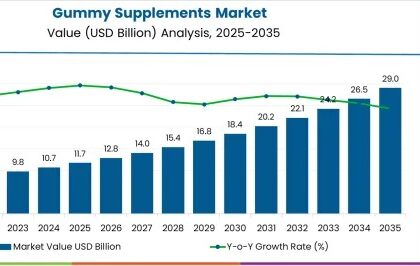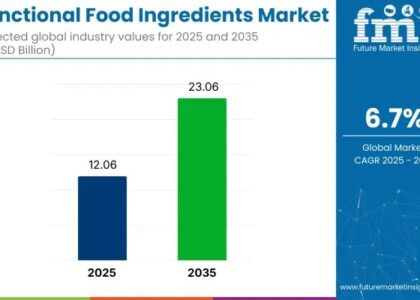In 2022, the global kraft paper bags market was valued at US$ 4.02 billion, and it is projected to witness substantial growth, with a consistent Compound Annual Growth Rate (CAGR) of 6.7% from 2023 to 2033. By 2023, the market is anticipated to climb to US$ 4.29 billion, further accelerating to US$ 8.2 billion by 2033. This upward trajectory underscores the increasing demand for eco-friendly packaging solutions, driven by environmental concerns and shifting consumer preferences towards sustainable alternatives. The kraft paper bags market is poised for significant expansion, fueled by a burgeoning emphasis on recyclability and eco-conscious packaging practices.
As concerns about environmental sustainability rise, there is a shift away from traditional plastic bags, notorious for taking 450 to 500 years to decompose, towards compostable kraft paper bags. These eco-friendly alternatives, favored for their style and environmental benefits, are increasingly adopted by major corporations, offering a long-lasting solution while minimizing damage and contamination to water and land. Additionally, the simplicity of creating and disposing of biodegradable kraft paper bags makes them an attractive choice, particularly for retailers aiming to enhance their eco-conscious image and promote recycling and reuse among consumers.
Request for a sample of this research report: https://www.futuremarketinsights.com/reports/sample/rep-gb-11362
In various settings such as foodservice restaurants, retail outlets, shopping malls, groceries, and more, kraft paper bags find widespread use. Renowned packaging manufacturers favor kraft paper as a material for crafting diverse paper bags, leveraging its attributes of high tear resistance and significant stiffness. These kraft paper bags emerge as a viable alternative to traditional plastic bags, offering advantages such as cost-effectiveness, improved food-grade quality, and easy disposal. Additionally, the versatility of kraft paper allows for the printing of various patterns, facilitating brand awareness among consumers.
The East Asia and South Asia regions are anticipated to hold a significant portion of kraft paper bags market share during the upcoming years. European Countries are expected to follow the East Asia region in terms of market growth. The rapid expansion of food and beverage industries in countries such as the United Kingdom, Germany, and Italy are creating an astonishing demand for kraft paper bags in this region. Furthermore, shifting inclination towards sustainable packaging solutions and improvisation in the retail industry in North America and Latin America region is also contributing substantially to the kraft paper bags market growth.
Market Drivers:
- Sustainability Awareness: Growing environmental consciousness among consumers and businesses drives the demand for eco-friendly packaging solutions like Kraft paper bags. These bags are biodegradable, recyclable, and made from renewable resources, making them a preferred choice over plastic bags.
- Government Regulations: Stringent regulations and policies aimed at reducing plastic usage and promoting sustainable alternatives boost the demand for Kraft paper bags. Many governments worldwide are imposing bans or levying taxes on single-use plastics, encouraging the adoption of paper-based packaging solutions.
- Consumer Preferences: Increasing consumer preference for sustainable, natural, and organic products contributes to the demand for Kraft paper bags. Brands seeking to align with consumer values often opt for environmentally friendly packaging, driving the market growth for Kraft paper bags.
- Retail and Food Service Industries: The retail sector, including grocery stores, supermarkets, and restaurants, extensively uses Kraft paper bags for packaging various products such as groceries, takeout meals, and bakery items. The expansion of these industries globally fuels the demand for Kraft paper bags.
- Brand Image and Marketing: Many companies utilize Kraft paper bags as part of their branding strategy to convey an eco-friendly and socially responsible image. The aesthetic appeal and customizable nature of Kraft paper bags make them an attractive choice for enhancing brand visibility and customer engagement.
Market Restraints:
- Cost Considerations: While Kraft paper bags offer numerous environmental benefits, they can be relatively more expensive to produce compared to plastic bags. This cost disparity can deter some businesses, particularly smaller enterprises with tight budgets, from adopting Kraft paper bags on a large scale.
- Durability Concerns: Although Kraft paper bags are suitable for many applications, they may not be as durable or water-resistant as their plastic counterparts. Concerns regarding the strength and protection offered by paper bags in certain conditions, such as during transportation or in wet environments, may limit their usage in specific industries.
- Competition from Alternative Materials: The Kraft paper bags market faces competition from alternative packaging materials, including compostable plastics, fabric bags, and reusable containers. Depending on specific requirements such as durability, flexibility, or cost-effectiveness, businesses may opt for alternatives instead of Kraft paper bags.
- Supply Chain Challenges: Fluctuations in the supply of raw materials, such as pulp and paper, can impact the availability and pricing of Kraft paper bags. Additionally, logistical issues in sourcing, manufacturing, and distributing these bags may pose challenges to market players, affecting overall market growth.
- Technological Limitations: Although advancements in paper manufacturing technologies have improved the quality and properties of Kraft paper bags, certain limitations remain, such as barrier properties against moisture and grease. Innovations in materials science and packaging technology are necessary to address these limitations and enhance the performance of Kraft paper bags.
Key Players
Some of the leading manufacturers of kraft paper bags are
- International Paper,
- WestRock Company,
- Druk Exporting Company,
- Aeroplast Ltd.,
- Novolex,
- Dharmanandan Offset,
- Jagisa Packaging Industries, and
- other local kraft paper manufacturers.
Buy Now/Purchase: https://www.futuremarketinsights.com/checkout/11362
Key Segmentations:
On the basis of material type
- Solid Unbleached Board
- Solid Bleached Board
- Virgin Bleached Board
- Others
On the basis of thickness
- 2 ply
- 2 & 3 ply
- Above 3 ply
On the basis of sales channel
- Manufacturers
- Distributors
- Retailers
- Hypermarkets
- Specialty Stores
- Convenience Stores
- Warehouse/Wholesale Clubs
- E-retail
On the basis of end use industry
- Food & Beverage Industry
- Retail
- Homecare & Personal Care
- Healthcare & Pharmaceutical
- Agriculture
- Others
About Future Market Insights (FMI)
Future Market Insights, Inc. (ESOMAR certified, recipient of the Stevie Award, and a member of the Greater New York Chamber of Commerce) offers profound insights into the driving factors that are boosting demand in the market. FMI stands as the leading global provider of market intelligence, advisory services, consulting, and events for the Packaging, Food and Beverage, Consumer, Technology, Healthcare, Industrial, and Chemicals markets. With a vast team of over 5000 analysts worldwide, FMI provides global, regional, and local expertise on diverse domains and industry trends across more than 110 countries.
Contact Us:
Future Market Insights Inc.
Christiana Corporate, 200 Continental Drive,
Suite 401, Newark, Delaware – 19713, USA
T: +1-845-579-5705
For Sales Enquiries: sales@futuremarketinsights.com
Website: https://www.futuremarketinsights.com
LinkedIn| Twitter| Blogs | YouTube






